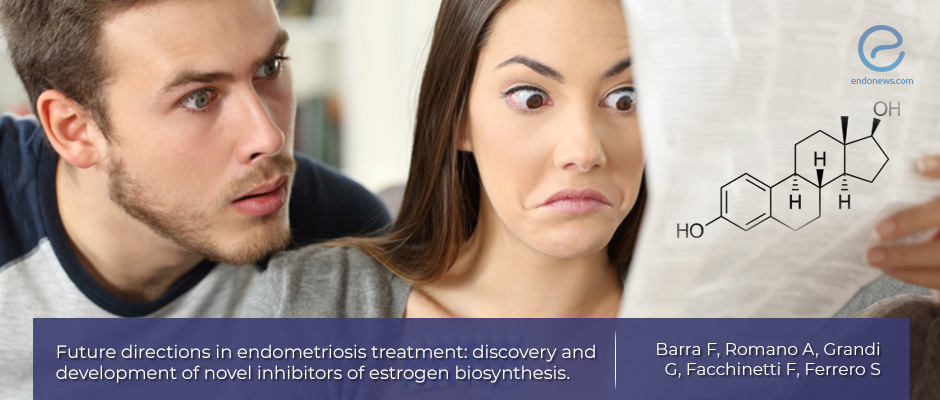Novel inhibitors of estrogen biosynthesis
Jun 14, 2019
Dr. Ferrero group suggest that the generation of inhibitors blocking the local estrogen biosynthesis is the future direction in endometriosis treatment
Key Points
Highlight:
- Dr. Ferrero group introduce several novel inhibitors targeting the local estrogen biosynthesis and discuss their advantages and limitations.
Background:
- In endometriosis, estradiol creates a positive feedback loop with the synthesis of pro-inflammatory mediators, which sustains further disease establishment and causes the pain symptoms.
- Inhibition of estradiol is highly critical, but, hormone therapies inevitably recur, and there is no clear evidence that hormonal drugs improve spontaneous fertility of patients with endometriosis.
- Development of new molecules acting on the local production of estradiol is particularly attractive in pharmacological research for treating endometriosis.
Key points:
- The first example is the development of aromatase inhibitors. Aromatase is the enzyme that catalyzes the aromatization in estrogen synthesis.
- The continuous oral administration of aromatase inhibitors (letrozole and anastrozole) was able to reduce the severity of pain symptoms and to improve the quality of life.
- The second example is the development of STS inhibitors.
- They block STS activity in conjugated forms of estradiol. The phase II clinical trial is ongoing with concomitant administration of NETA for the endometriosis treatment.
- Thirdly, the development of 17β-HSD-1 inhibitors.
- Targets the final activation step of estradiol from estrone by 17β-HSD-1, and proved to be efficient in various animal models of breast, endometrial cancer, and endometriosis.
- Recently entered the first clinical trial, aiming at investigating the safety, tolerability, food effect and pharmacokinetics of a variety of oral doses.
- The last example is the inhibitors for AKR1C3.
- This enzyme catalyzes the reduction of estrone to estradiol.
- It shows efficacy, but a recent phase II clinical trial preliminary ended due to the development of drug-related hepatotoxicity.
Conclusions:
- The aim of finding alternative targets in the estrogen synthesis is to achieve a more specific inhibition within endometriotic implants, limiting the impact of the treatment on the systemic hormonal environment.
- However, careful evaluation is necessary before the clinical trial and/or practice.
Lay Summary
Endometriosis is a chronic benign disease which is estrogen-dependent. Estradiol creates a positive feedback loop with the synthesis of pro-inflammatory mediators, which sustains further disease establishment and causes the pain symptoms. However, hormone therapies do not cure definitively endometriosis, because of recurrence and lack of evidence that hormonal drugs improve spontaneous fertility of patients with endometriosis.
Recently, several studies provided strong evidence that aberrant in-situ estrogen biosynthesis occurs in endometriosis. Therefore, the development of new molecules acting on such local production of estradiol is particularly attractive in pharmacological research for treating endometriosis. Here, Dr. Ferrero group from the University of Genoa in Italy, introduce new inhibitors which inhibit estrogen activity for treating endometriosis and discuss their advantages and limitations. This paper was recently published in the journal “Expert Opinion on Investigational Drugs”.
The first example is the development of aromatase inhibitors. Systematic literature review suggests that the continuous oral administration of aromatase inhibitors (letrozole and anastrozole) was able to reduce the severity of pain symptoms and to ameliorate the patient quality of life. Though there are several problems such as poor design, administration, and side effects, the research of alternative delivery formulations of aromatase inhibitors is still attractive.
The second example is the development of STS inhibitors which block STS activity in conjugated forms of estradiol. Estradiol-3-O-sulfamate (E2MATE) has appeared as a reliable therapeutic option after promising studies in vivo and in the animal model of endometriosis. This led to an ongoing phase II clinical trial of STS inhibitor E2MATE with concomitant administration of NETA for the endometriosis treatment.
The third example is the development of inhibitors which target the final activation step of estradiol from estrone by 17β-HSD-1. HSD17B1-inhibitors proved to be efficient in various animal models of breast, endometrial cancer, and endometriosis. A novel HSD17B1-inhibitor recently entered the first clinical trial; a randomized, double-blind, placebo-controlled phase I trial aimed at investigating the safety, tolerability, food effect and pharmacokinetics of single and multiple ascending oral doses.
The last example is the inhibitors for AKR1C3 (also known as 17β-HSD-5) which catalyzes the reduction of estrone to estradiol. Because of the possibility to inhibit multiple endometriosis-relevant signaling, 17β-HSD-5 attracted considerable attention as a novel drug target. However, a recent phase II clinical trial preliminary ended due to the development of drug-related hepatotoxicity.
According to Dr. Ferrero, the aim of finding alternative targets in the estrogen synthesis is to achieve a more specific inhibition within endometriotic implants, limiting the impact of the treatment on the systemic hormonal environment. However, a careful evaluation of long-lasting efficacy, tolerance, and safety of investigational compounds is necessary before they can be considered for reliable use in the clinical practice.
Research Source: https://www.ncbi.nlm.nih.gov/pubmed/31072144
Endometriosis Estrogen biosynthesis AKR1C3 Steroid sulphatase 17β-hydroxysteroid dehydrogenase 1 Aromatase inhibitors

